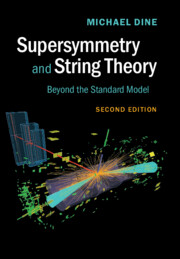Book contents
- Frontmatter
- Dedication
- Contents
- Preface to the First Edition
- Preface to the Second Edition
- A note on the choice of metric
- Text website
- Part 1 Effective field theory: the StandardModel, supersymmetry, unification
- Part 2 Supersymmetry
- Part 3 String theory
- 20 Introduction
- 21 The bosonic string
- 22 The superstring
- 23 The heterotic string
- 24 Effective actions in ten dimensions
- 25 Compactification of string theory I. Tori and orbifolds
- 26 Compactification of string theory II. Calabi–Yau compactifications
- 27 Dynamics of string theory at weak coupling
- 28 Beyond weak coupling: non-perturbative string theory
- 29 Large and warped extra dimensions
- 30 The landscape: a challenge to the naturalness principle
- 31 Coda: Where are we heading?
- Part 4 Appendices
- References
- Index
23 - The heterotic string
from Part 3 - String theory
- Frontmatter
- Dedication
- Contents
- Preface to the First Edition
- Preface to the Second Edition
- A note on the choice of metric
- Text website
- Part 1 Effective field theory: the StandardModel, supersymmetry, unification
- Part 2 Supersymmetry
- Part 3 String theory
- 20 Introduction
- 21 The bosonic string
- 22 The superstring
- 23 The heterotic string
- 24 Effective actions in ten dimensions
- 25 Compactification of string theory I. Tori and orbifolds
- 26 Compactification of string theory II. Calabi–Yau compactifications
- 27 Dynamics of string theory at weak coupling
- 28 Beyond weak coupling: non-perturbative string theory
- 29 Large and warped extra dimensions
- 30 The landscape: a challenge to the naturalness principle
- 31 Coda: Where are we heading?
- Part 4 Appendices
- References
- Index
Summary
In the Type II theory we have seen that the left and right movers are essentially independent. At the level of the two-dimensional Lagrangian, there is a reflection symmetry between left and right movers; however, this symmetry does not hold sector by sector and is broken by boundary conditions and projectors.
In the heterotic theory this independence is taken further, and the degrees of freedom of the left and right movers are taken to be independent – and different. There are two convenient world-sheet realizations of this theory, known as the fermionic and bosonic formulations. In both there are eight left-moving and eight right-moving XIs, associated with ten flat coordinates in space–time. There are eight right-moving two-dimensional fermions, ψI. There is a right-moving supersymmetry but no left-moving supersymmetry. In the fermionic formulation there are, in addition, 32 left-moving fermions which have no obvious connection with space–time, λA. In the bosonic description there are an additional 16 left-moving bosons. In other words, there are 24 left-moving bosonic degrees of freedom. There are actually several heterotic string theories in ten dimensions. Rather than attempt a systematic construction, we will describe the two supersymmetric examples. These have gauge groups O(32) and E8 × E8. The group E8, one of the exceptional groups in Cartan's classification, is not very familiar to most physicists. However, it is in this theory that we can most easily find solutions which resemble the Standard Model. We will introduce certain features of E8 group theory as we need them. More detail can be found in the suggested reading. In this chapter we will work principally in the fermionic formulation. We will develop some features of the bosonic formulation in later chapters, once we have introduced the compactification of strings.
TheO(32) theory
The O(32) (SO(32)) theory is somewhat simpler to write down, so we will develop it first. In this theory the 32 λA fields are taken to be on an equal footing. The GSO projector, for the right movers, is as in the superstring theory. In the RNS formalism, in the NS sector we keep only states of odd fermion number and similarly in the Ramond sector, where fermion number includes a factor eiΓ11. For the left movers, the conditions are different. Again, we have a Ramond and an NS sector.
- Type
- Chapter
- Information
- Supersymmetry and String TheoryBeyond the Standard Model, pp. 335 - 339Publisher: Cambridge University PressPrint publication year: 2016

